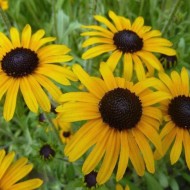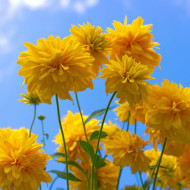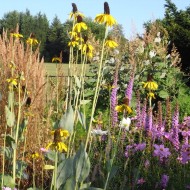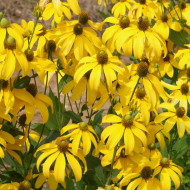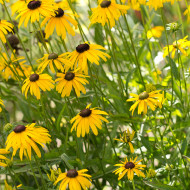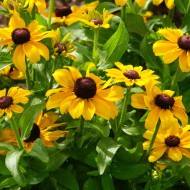Perennial rudbeckia in garden design: interesting species and varieties with photos
Content
Features of perennial rudbeckia
The herbaceous plant of the Aster family came to us from the North American prairies. When European settlers saw an unusual flower, they named it "sun hat" or "black-eyed Suzanne". However, the current scientific name was given to him by Karl Linnaeus in honor of the Swiss family of botanists Rudbekov.
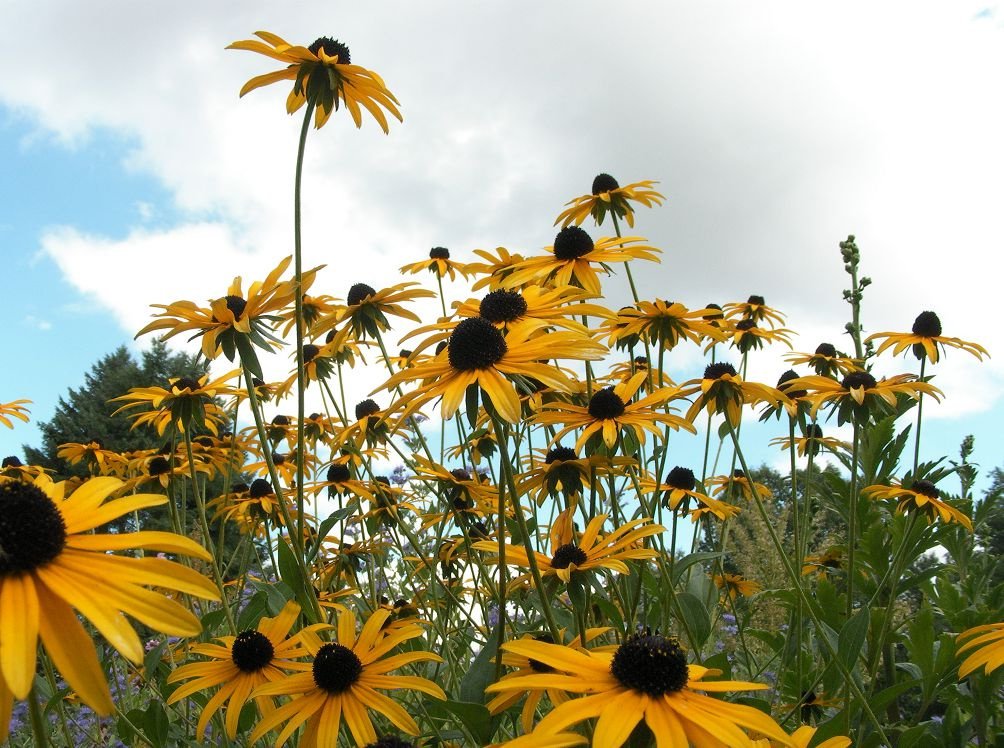
In its natural environment, rudbeckia is found in the United States, European and African countries. In regions of the middle climatic zone, it is grown as an annual crop, but to the south, it is already possible to cultivate perennial varieties.
Highly decorative culture is a bush 0.5-3 m high with erect single or branched shoots. Leaf plates 5-20 cm in size are of two types: sessile ones are located closer to the top of the plant, on cuttings - at the base. Depending on the variety, their shape is round, egg-shaped or feathery. Inflorescences-baskets with a diameter of 8-19 cm are distinguished by a variety of colors (from lemon yellow to inky purple). After flowering, oblong seed pods with dark gray small seeds are formed on the stems.
The main types of plants
Botany knows more than 40 varieties of rudbeckia, most of which are artificially bred varieties. For convenience, flower growers have classified all types of this decorative culture into groups. Read more about each below.
Lustrous, or radiant (Rudbeckia fulgida)
Medium growing plant 0.5-0.6 m high. Stems are upright, covered with hard hair. Leaves are lanceolate, elongated, pubescent. Baskets, about 90 mm in size, consist of narrowed reed petals at the edges and tubular at the center. The color is yellow-orange with a burgundy-brown convex core. The most famous varieties of brilliant rudbeckia are Goldstar (Goldstar) and Goldsturm (Goldsturm or Goldstream).
Dissected (Rudbeckia laciniata)
With proper care, it grows above two meters, has a powerful branched root system. Shoots are erect, covered with narrow pointed leaves. Terry inflorescences, about 10 cm in size, consist of several rows of bright yellow petals, framing tubular light green flowers located in the center. The most popular among flower growers is the Golden Ball dissected rudbeckia.
Western (Rudbeckia occidentalis)
Differs in an unusual form for this culture. The basket is a highly convex dark brown cone, consisting of tubular petals. Sometimes small (no more than 2 mm) reed flowers can be placed in a circle.The western rudbeckia grows up to one and a half meters in height, forming an original bush, more like dead wood. The most famous hybrid is Black Beauty.
Giant (Rudbeckia maxima)
A tall plant with a height of more than two meters with large (about 15 cm) inflorescences. Stems are upright, covered with ovoid leaves. The surface of the leaf plates is pubescent, in the sun it casts a bluish tint. Baskets consist of a conical dark center and flat reed petals of a solar color. Giant rudbeckia is the most unpretentious species that looks good when cut.
- Rudbeckia fulgida
- Rudbeckia laciniata
- Rudbeckia occidentalis
- Rudbeckia maxima
Glossy (Rudbeckia nitida)
A large ornamental bush that grows almost two meters. Densely leafy straight stems are covered with glossy, smooth ovoid leaf plates. Inflorescences 10-12 cm in diameter consist of one row of lemon-yellow marginal petals and dark green tubular flowers in the center. The most famous varieties are Gold Shirm and Herbstsonne.
Beautiful or lovely (Rudbeckia speciosa)
Low-growing, compact culture up to half a meter in height. Shoots are erect, densely covered with oval, slightly elongated leaf plates. Baskets are large, about 10 cm in size, bright yellow in color, with dark red strokes at the base. Flat, elongated, sun-colored reed petals encircle burgundy-brown tubular flowers, collected in the center.
Hybrid (Rudbeckia hybrida)
This group combines hybrid forms of hairy, glossy and dissected rudbeckia. All of them are tall, with giant inflorescences up to 19 cm in size. Ligulate petals are long, 12-15 cm, warm amber tones. For tubular flowers, an inky purple color is characteristic. The most popular varieties among florists are Mokka and Double Daisy.
Perennial rudbeckia is often confused with Echinacea purpurea, and although both plants belong to the same family, they belong to different genera.
- Rudbeckia nitida
- Rudbeckia speciosa
- Rudbeckia hybrida
The best varieties of perennial rudbeckia
Thanks to the efforts of breeders, a wide variety of varieties and hybrids are available to flower growers today. Read on about the brightest representatives of this ornamental solar plant.
Golden ball
A perennial variety almost 2.5 m high. The leaf plates are bright green, pinnately dissected. Inflorescences are spherical, densely filled with lemon-yellow terry petals. Golden Ball is unpretentious to the soil and tolerates low temperatures well, but does not like drought.
Cherry Brandy
A short cultivar that rarely grows more than half a meter. Baskets are rather large, consisting of burgundy-red flat petals and dark brown tubular flowers. Cherry Brandy loves sunny outdoor areas as well as regular grooming.
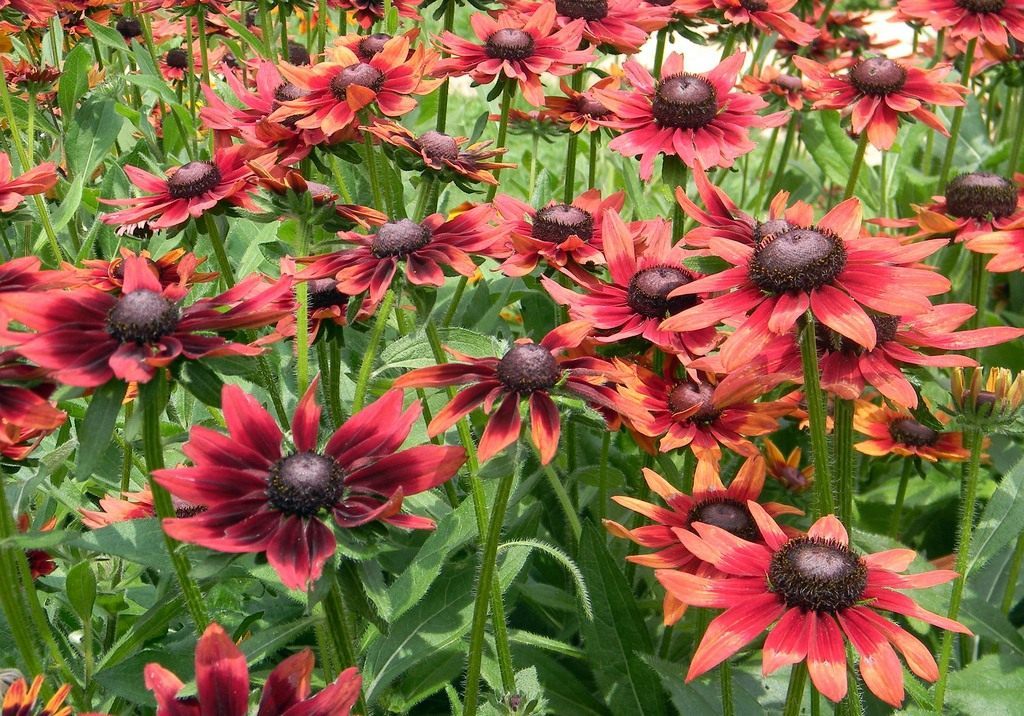
Julie Gold
Medium-sized hybrid with compact bright bushes up to 1 m high. Stems are upright, medium-leafy. The inflorescences consist of several rows of flat yellow-orange petals and a convex burgundy-brown core. The variety is resistant to diseases, does not require shelter for the winter.
Double Daisy
Cultivar about 1.2 m high with large (15-17 cm) double inflorescences. Shoots are vertical, rigidly pubescent. The leaves are ovoid, covered with a hard nap. The color of the marginal petals is variegated, the tubular petals are dark brown. Double Daisy is light-requiring, resistant to infections.
Red umbrella
Tall shrub with lanceolate, smooth leaf blades. It blooms in baskets, consisting of small petals of purple-lilac color and tubular flowers of orange-brown color. The hybrid has good immunity, but it can be susceptible to powdery mildew.
Irish Eyes
Medium-sized variety with straight, pubescent stems covered with narrow, long leaves. Baskets are large, consisting of bright lemon flat petals surrounding a light green convex core. Rudbeckia is distinguished by abundant flowering and loves good lighting.
Golden curls
A low cultivar (0.7 m) with semi-double inflorescences-baskets up to 10 cm in diameter. Long bright yellow petals arranged in several rows reveal a round dark brown middle. The hybrid is frost-resistant, photophilous, requires regular watering.
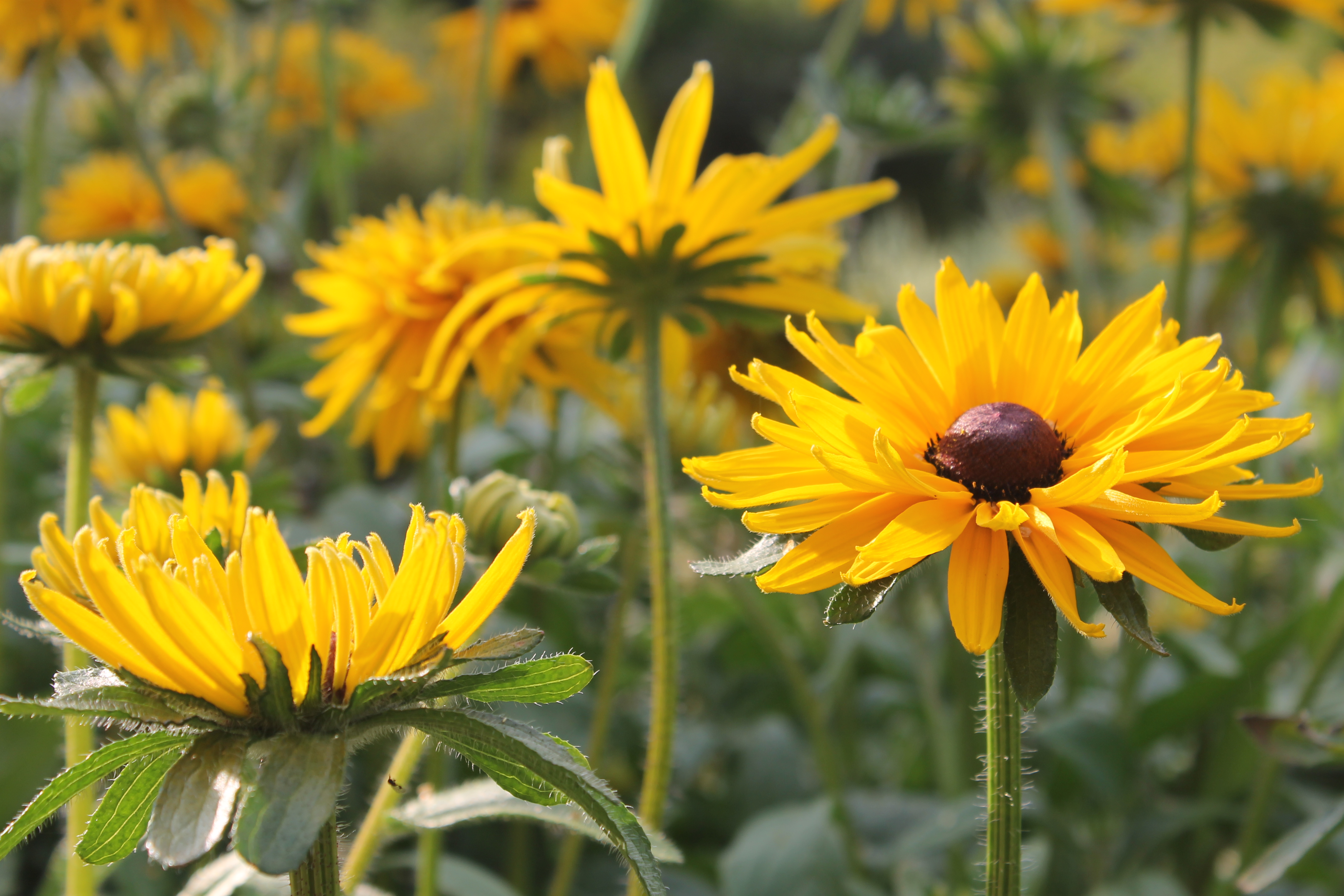
Goldkel
Dissected rudbeckia about one meter high. Leaves are light green, elongated, with jagged edges. The flowers are densely double, 10-15 cm in size, and consist of densely planted golden yellow petals. The plant loves well-lit areas and moist, nutritious soil.
Gloriosa Daisy
Medium-sized variety, growing up to 1-1.2 m. Baskets are large, 14-16 cm in diameter. Petals are variegated or monochromatic, arranged in 2-3 rows, surrounding a tubular burgundy-brown core. Gloriosa Daisy is not demanding on the composition of the soil, and also does not need additional care.
Toto Gold
A miniature compact bush with a height of only 0.2-0.3 m. It blooms in small (about 50 mm) simple baskets of a golden yellow hue. The dwarf cultivar is best suited for growing in containers, pots or flowerpots.
Toto Gold looks good when decorating window openings, balconies or terraces.
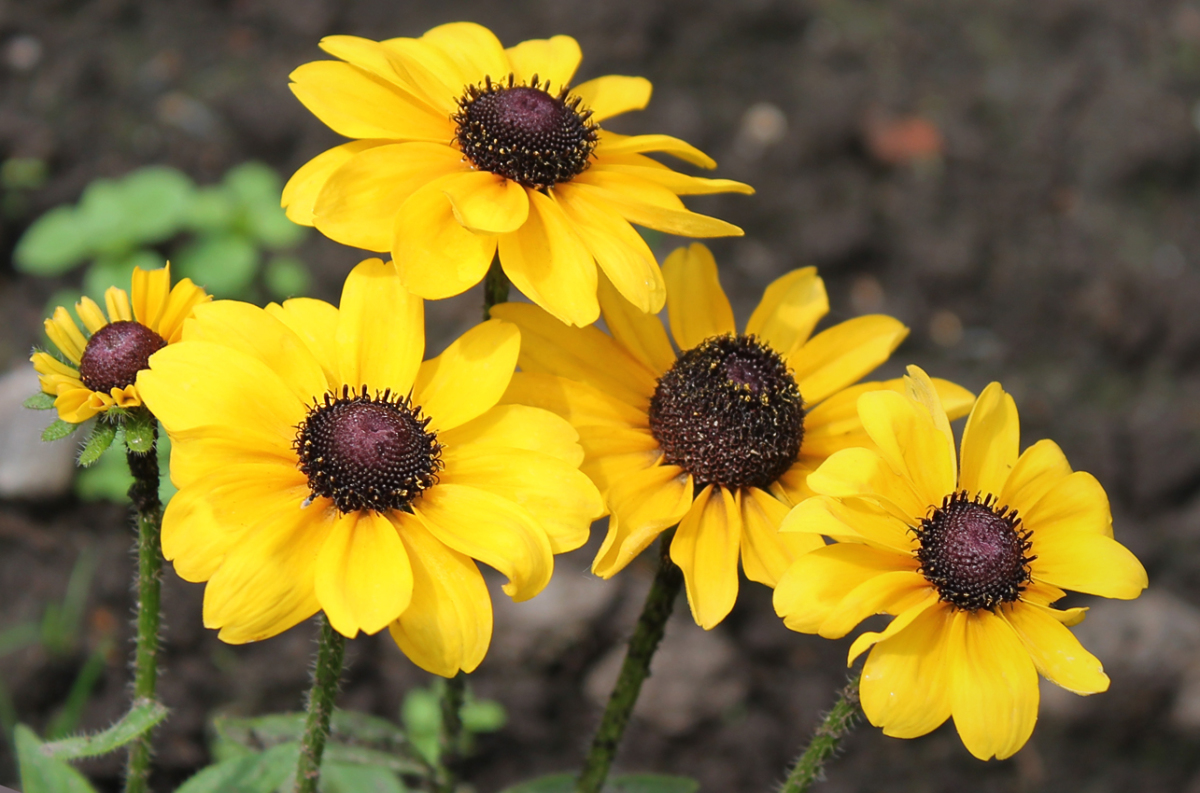
Black Beauty
Tall hybrid (1.2-1.5 m) with inflorescences unusual for rudbeckia. The edge petals of Black Beauty are practically absent, and the basket itself is represented by a large ink cone, consisting of small tubular flowers. The plant is unpretentious, in the garden it looks like a dried flower.
Moreno
Artificially bred variety of hairy rudbeckia. A medium-sized bush, growing to 0.5-0.6 m. During flowering, it throws out inflorescences with a diameter of about 15 cm. Ligulate petals of a velvet texture, burgundy-red. Tubular chocolate-colored flowers with yellow anthers.
Denver Daisy
Another hairy hybrid, with vertical stems up to 0.9 m long. Baskets look like chamomile, but they are distinguished by an unusual bicolor color. The marginal petals are bright yellow with burgundy-chocolate thick strokes at the base. The core is convex, dark brown.
Cordoba
Compact bushes of medium height (0.5-0.6 m) look best in flowerpots or containers. Inflorescences are large, amber-yellow, with a chocolate-brown core. Cordoba loves bright lighting and regular watering. Resistant to infections, but can be affected by caterpillars.
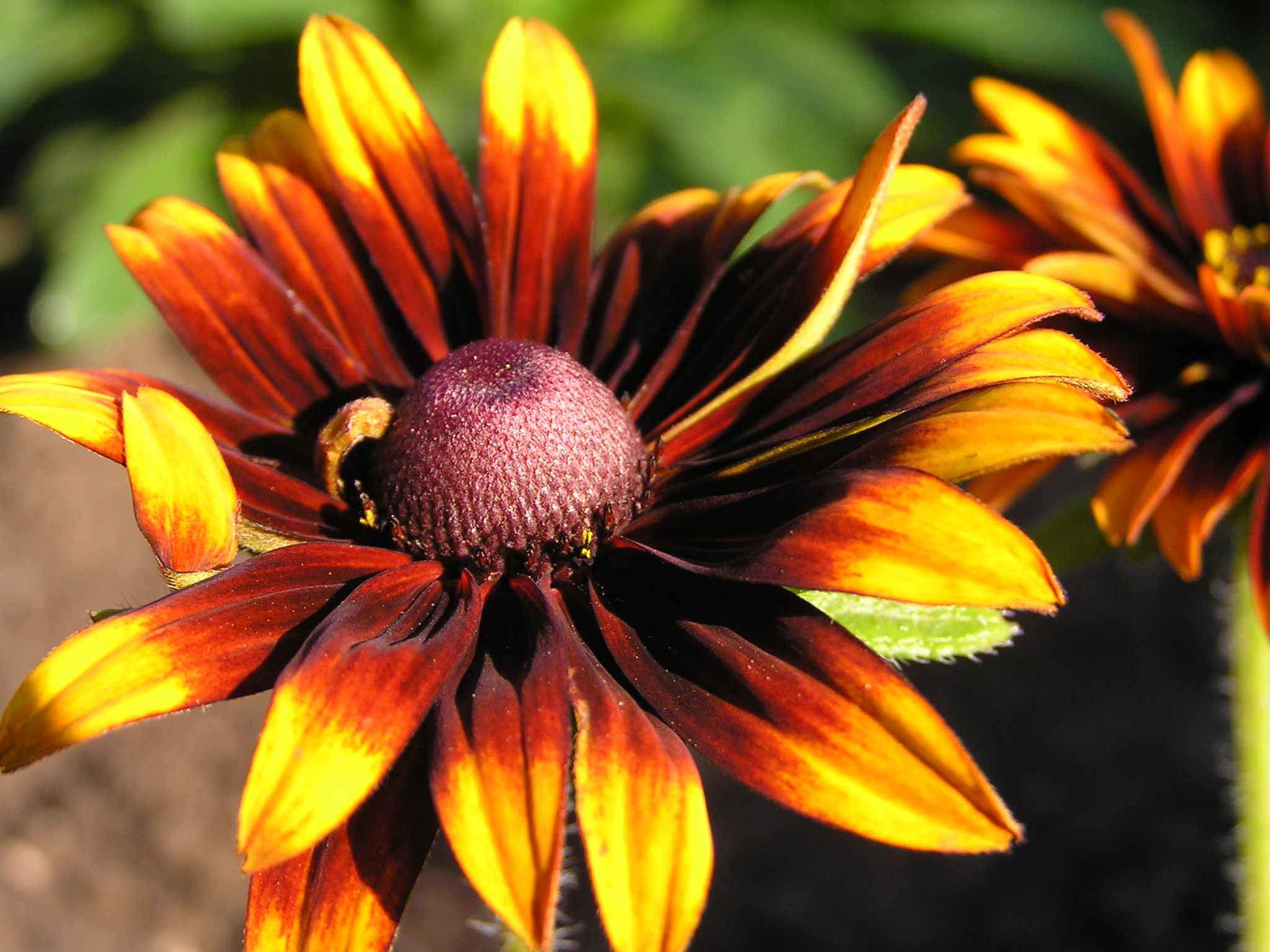
Moroccan San
An annual variety with lush bushes 0.5x0.6 m in size. Baskets are densely double, with densely planted petals of a sunny palette (from lemon-yellow to orange-red). The hybrid feels good in open sunny areas, loves moist, nutritious soil.
Video "All about growing rudbeckia"
In this video, experts talk about the rules for planting and caring for horticultural crops.
Creation of landscape compositions with rudbeckia
Bright lush bushes will look good on any garden plot. They can be planted separately or mixed with other flowers. They are great at filling voids or hiding aesthetic defects in the garden. Sometimes decorative culture is used to design fences, open gazebos, curb planting.

Chrysanthemums, asters, echinacea are distinguished by their harmonious neighborhood with the solar plant. Ornamental cereals, phlox, goldenrod planted nearby also look good. The culture looks most advantageous in combination with white, red, blue or pink shades.
The unusually bright and warm rudbeckia is not in vain so loved by many flower growers. Amber autumn flowers are not only unpretentious to maintain, but also form a sunspot, decorating an already fading area.

